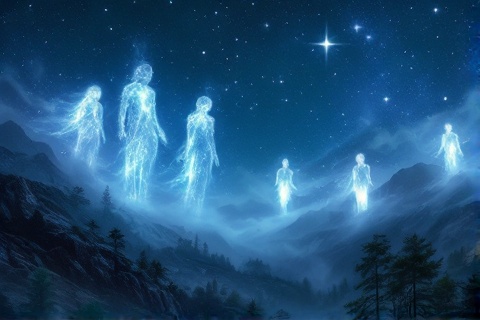
Maiar: The Hidden Spirits of Middle-earth
Unveiling the Powers, Mysteries, and Legends of Tolkien's Lesser-Known Immortals
Origins in the Music of the Ainur
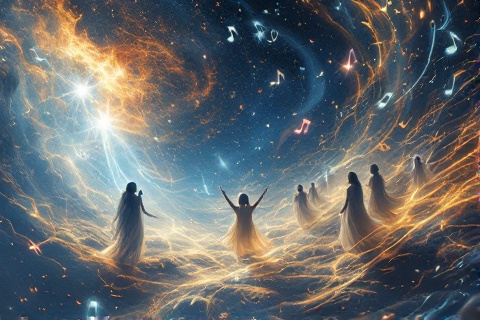
The Maiar emerged from the thought of Eru Ilúvatar as part of the Ainur, the
primordial spirits who existed before the creation of Arda. These powerful
beings stood as the younger siblings to the mighty Valar in the
hierarchy of spiritual entities within Tolkien's legendarium. While their exact
number remains unknown, they formed an essential part of the divine order
established by Ilúvatar.
Though less powerful than their elder kindred the Valar, the Maiar possessed
tremendous abilities that set them far above the Children of Ilúvatar. Their
powers included the ability to shape matter, influence the natural world, and
understand the deep mysteries of creation. Each Maia held specific strengths and
abilities that aligned with their nature and purpose in the great design of
Arda.
The Maiar played a crucial role in the Ainulindalë, the Great Music of the Ainur
that formed the blueprint for all of creation. Their voices joined with those of
the Valar in weaving themes of unimaginable beauty and complexity, contributing
their own unique melodies to the grand symphony that would later become the
physical world of Arda.
Following the creation of Arda through the Music, many Maiar chose to enter the
physical world alongside the Valar, becoming bound to its fate. These spirits
descended into the newly formed world to help shape and protect it, taking on
various responsibilities in accordance with their abilities and the needs of
Arda. Their decision to enter the physical realm demonstrated their commitment
to the vision of Ilúvatar and their desire to participate in the unfolding
history of the world.
Nature and Powers of the Maiar
The Maiar possessed the remarkable ability to change their physical appearance
at will, a power known as shape-shifting. While they could assume any form they
desired, most Maiar developed preferred forms that reflected their essential
nature and purpose. These chosen appearances, called fánar, ranged from
elemental manifestations to forms resembling the Children of Ilúvatar, depending
on their role and personality.
Each Maia possessed specific domains of power that aligned with their inherent
nature and often corresponded to the attributes of the Valar they served. Some
excelled in the mastery of fire, others in the understanding of water or air,
while still others demonstrated great skill in crafting, healing, or the
manipulation of physical matter. These specializations made each Maia unique and
particularly suited to certain tasks within the governance of Arda.
As immortal spirits, the Maiar could not truly die in the same way as the
Children of Ilúvatar. When their physical forms were destroyed, their spirits
endured, though their power might be diminished through defeat or the
expenditure of their strength in great works. This immortality was fundamental
to their nature as Ainur, though the way they experienced and expressed it
differed from that of the Valar.
Within the hierarchy of the Maiar, significant variations in power and ability
existed. Some, like Eönwë and Ilmarë, possessed might that approached that of
the lesser Valar, while others demonstrated more modest capabilities. These
differences in power often reflected their original purpose in the Music of the
Ainur and their chosen roles in the governance of Arda.
The Istari: The Maiar as Wizards
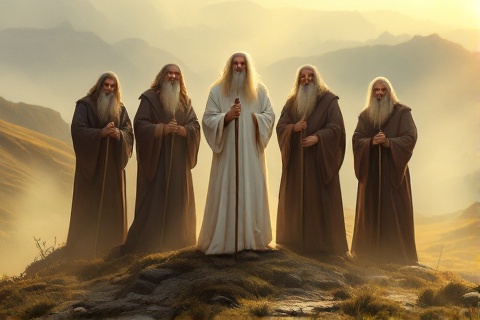
During the Third Age, five Maiar were chosen by the Valar to
journey to Middle-earth as the Istari, or
Wizards. These beings were sent specifically to aid in the struggle against
Sauron, who had reemerged as a grave threat to the free peoples. They arrived in
Middle-earth around the year 1000 of the Third Age, each tasked with the mission
of guiding and counseling rather than dominating through direct power.
The Istari were incarnated in the forms of elderly men, a deliberate choice that
came with significant limitations on their powers. These restrictions were
imposed to prevent them from matching Sauron's power directly and to ensure they
would guide rather than rule the peoples of Middle-earth. Their aging bodies
experienced weariness and could be killed, though their immortal spirits would
endure.
Among the five Istari, Saruman the White, Gandalf the
Grey, and Radagast the Brown played the most visible roles
in the history of the Third Age. Saruman, as the head of their order,
established himself at Isengard and became deeply learned in lore and crafts.
Gandalf traveled widely, working to unite the free peoples against evil.
Radagast focused his efforts on understanding and protecting the wildlife and
forests of Middle-earth.
Of all the Istari, only Gandalf remained steadfast in pursuing the mission set
forth by the Valar. After his sacrifice in Moria and return as Gandalf the
White, he successfully guided the free peoples to victory against Sauron. The
other wizards either failed in their mission, like Saruman who fell to
corruption, or disappeared from the main events of the Third Age, as did
Radagast and the two Blue Wizards.
Servants of the Valar
The majority of the Maiar aligned themselves with specific Valar, serving as
their assistants and sharing in their areas of influence and responsibility.
This association allowed the Maiar to learn from and support the work of their
chosen Valar, creating a harmonious system of governance over different aspects
of Arda. These relationships often reflected the natural inclinations and powers
of the Maiar themselves.
Eönwë, who served as the herald and banner-bearer of Manwë, stood as the most
skilled warrior among all the Maiar. His might in arms was unmatched, and he led
the hosts of the Valar in the War of Wrath against Morgoth at the end of the
First Age. The military prowess of Eönwë became legendary, and
his leadership proved crucial in the final defeat of the first Dark Lord.
Ilmarë served as the handmaiden of Varda, the Queen of the Stars, and assisted
in the care and arrangement of the heavenly lights. Her work complemented that
of her mistress, helping to create and maintain the beautiful patterns of stars
that would later become so beloved by the Elves. The collaboration between Varda
and Ilmarë exemplified the close working relationship between the Valar and
their chosen Maiar.
The Maiar Ossë and Uinen served under Ulmo, the Lord of Waters, helping to
govern the seas of Arda. Ossë delighted in the coastal waters and storms, while
his spouse Uinen brought calm to the seas and was beloved by mariners. Their
complementary nature demonstrated how Maiar working under the same Vala could
manifest different aspects of their master's domain.
The Fall of Dark Maiar
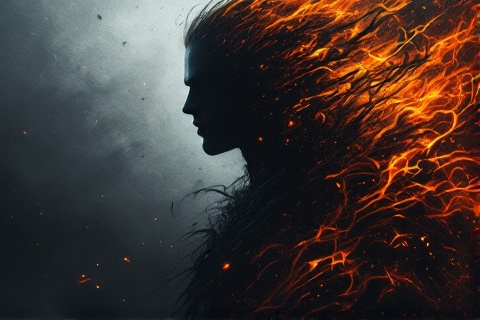
During the First Age, several Maiar fell under the influence of
Melkor, the first Dark Lord, becoming corrupted and
turning away from their original purpose. This corruption stemmed from Melkor's
ability to sway others to his cause through promises of power and freedom from
the constraints of serving the other Valar. The fall of these Maiar had
far-reaching consequences for the history of Middle-earth.
Among the fallen Maiar, Sauron, originally known as Mairon,
became the most notorious and dangerous. Initially a Maia of Aulë skilled in
crafts and organization, Sauron was seduced by Melkor's promises and became his
most trusted lieutenant. After Melkor's defeat, Sauron rose to become the
principal Dark Lord of Middle-earth, causing centuries of strife and warfare.
The Balrogs were Maiar of fire who aligned themselves with Melkor in the
beginning, becoming some of his most terrifying servants. These spirits of fire
and shadow used their considerable powers for destruction and terror, serving as
Melkor's elite warriors. The most famous confrontation with a Balrog occurred in
Moria, where Gandalf sacrificed himself to defeat Durin's
Bane.
The corruption of these Maiar profoundly influenced the conflicts that shaped
Middle-earth's history. Their fall from grace created some of the most dangerous
enemies the free peoples would face, and their actions led to countless wars and
suffering throughout the Ages. The struggle against these corrupted Maiar became
a central theme in the great tales of Middle-earth.
Maiar in Physical Form
The Maiar utilized physical forms called fánar to interact with the Children of
Ilúvatar and the physical world of Arda. These bodies were not mere illusions
but real physical manifestations that allowed the Maiar to experience the world
in ways similar to incarnate beings. The creation and maintenance of these forms
required conscious effort and energy from the Maiar.
Over time, some Maiar became so accustomed to their chosen forms that they
became bound to them, losing or diminishing their ability to change shape at
will. This process of becoming bound to a physical form was particularly common
among those Maiar who spent long periods in close interaction with the Children
of Ilúvatar. The more they used their physical forms, the more natural and
permanent these forms became.
The physical appearances chosen by the Maiar often reflected their inner nature
and the purpose they served in Arda. Those who worked closely with the Elves
often chose fair and noble forms, while those who dealt with the natural world
might take forms more closely connected to their domains of influence. This
choice of appearance served both practical and symbolic purposes in their
interactions with other beings.
When their physical forms were destroyed through violence or great catastrophe,
the Maiar faced the challenge of either rebuilding their bodies or remaining
formless. The process of reconstructing a physical form required significant
effort and power, and in some cases, like that of Sauron after the drowning of
Númenor, the new form might be limited by the Maia's
diminished strength.
Melian and the Elves
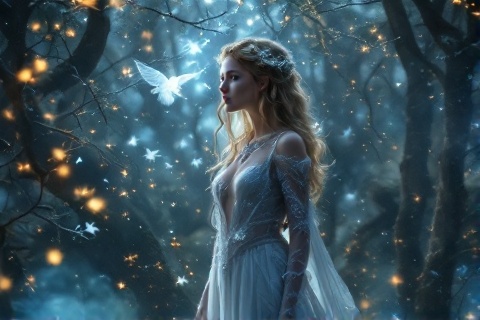
Melian stands unique among the Maiar as the only one known to have married one
of the Children of Ilúvatar, the Elf-king Elwë Singollo, also known as Thingol.
Their union in the forests of Beleriand during the Years of
the Trees marked an unprecedented joining of the
divine and the incarnate. This marriage brought profound consequences for the
history of Middle-earth and established a lineage that would shape the destiny
of both Elves and Men.
Using her considerable powers, Melian created an enchanted barrier known as the
Girdle of Melian around the kingdom of Doriath. This
impenetrable wall of shadow and bewilderment protected the realm from all who
would enter without permission, except those with power greater than Melian's
own. The Girdle stood as one of the greatest works of magic ever achieved in
Middle-earth, maintaining the safety of Doriath for centuries.
The wisdom and power of Melian greatly influenced the course of events in the
First Age. Her counsel guided the actions of King Thingol and the people of
Doriath, while her foresight provided warnings of coming dangers. She understood
much about the nature of the world and the intentions of both good and evil
powers, making her guidance invaluable to those who sought it.
Through her daughter Lúthien, Melian became the
ancestor of both Elven and Human royal lines. This unique heritage passed down
through the ages, manifesting in descendants such as Elrond, Elros, and
eventually the kings of Númenor and Gondor. The blood of the
Maiar that flowed through this lineage granted special grace and power to these
descendants, marking them as extraordinary among their peoples.
Legacy and Influence
Throughout the history of Middle-earth, the actions and influences of the Maiar
proved fundamental in shaping major events and the overall destiny of Arda. From
the creation of the world through the Music of the Ainur to the final defeat of
Sauron at the end of the Third Age, these powerful spirits played crucial roles
in both the preservation and the marring of Arda. Their decisions and
interventions often determined the outcome of critical moments in history.
The unique bloodline established through Melian and Lúthien continued to
influence events long after the First Age. This heritage manifested in the
extraordinary abilities and destinies of their descendants, including the
Half-elven and the kings of Númenor and Gondor. The grace and power inherited
from their Maiarin ancestor contributed to their capacity for great deeds and
leadership among their peoples.
The wisdom and knowledge possessed by the Maiar served as a guiding light for
the Free Peoples of Middle-earth throughout its history. Whether through direct
counsel like that of Gandalf or through the preserved knowledge passed down
through generations, the understanding and insight of the Maiar helped the
Children of Ilúvatar navigate the challenges they faced and make crucial
decisions in times of need.
The eternal struggle between the Maiar who remained faithful to their original
purpose and those who fell into darkness represented one of the central themes
in Tolkien's legendarium. This conflict exemplified the broader battle between
good and evil, demonstrating how even the most powerful and wise beings could
choose their path and how these choices affected the fate of all in
Middle-earth.
